Menu
Download the accompanying materials to this lesson plan - sign up here
Resources and materials for ESL Kids teachers
Answer: the present simple tense.
When talking about everyday, habitual activities we use the present simple tense. This shows that these are things we do on a regular basis.
The present simple tense for daily routines is formed as follows:
This lesson will be drawing on aspects studied in a couple of previous lessons, so make sure it is taught after the telling the time lesson and the morning routines lesson.
See our "Warm Up & Wrap Up" page.
1. Introduce 4 times of the day: morning, afternoon, evening and night
Quickly introduce the 4 words by drawing a picture on the board:
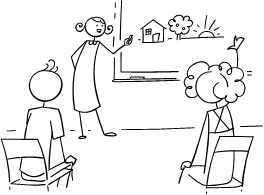
Next erase the moon and starts and invite a student up to the board. Say, "Draw afternoon". Help if necessary and have the student draw the sun high in the sky. Erase the sun and invite other students to draw the other times of the day.
2. Play "Times of the day boxes" game
You will need to prepare 5 cardboard boxes and print the flashcards for morning, afternoon, evening, night, wake up, get up, eat breakfast, eat lunch, eat dinner, go to school, start school, go home, arrive home, watch TV, do homework, go to bed. You can also add some other flashcards for daily routines, such as brush teeth, play video games, etc. The more flashcards, the better.
On 4 of the boxes, stick one of the morning, afternoon, evening and night flashcards on the outside of each and place in different corners of your classroom. In the remaining box put lots of small objects, e.g. balls, bean bags, blocks, etc. and place in the middle of the classroom.
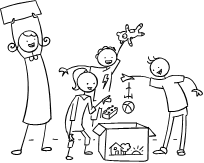 Model the activity: hold up one of the flashcards (e.g. "get up") - say the word "get up". Then pick up an object from the object box and point to the 4 boxes around the room. Ask "Which one?" and then go and drop the object into the morning box. Say "morning" as you drop the object into the box.
Model the activity: hold up one of the flashcards (e.g. "get up") - say the word "get up". Then pick up an object from the object box and point to the 4 boxes around the room. Ask "Which one?" and then go and drop the object into the morning box. Say "morning" as you drop the object into the box.
Now let's start the game. Hold up a flashcard (any from the daily routines set) and shout out the verb (e.g. eat dinner). Get everyone to come up together, pick up an object and drop it in the correct box (make sure they say the time of the day word as they drop). Then proceed through all of the flashcards quickly as students rush around the classroom putting objects into the correct boxes. It may be the case that some students will need to visit two boxes for some activities (e.g. watch TV could be morning and evening) - this is fine.
Finally, ask everyone to guess which box has the most objects - then count out the objects in each box to see which is the winning time of the day!
3. Create a "Times of the Day" chart on the board
If you don't have a board, you can use a large sheet of paper stuck to your wall. Draw a vertical and horizontal line to create 4 equal squares and title each square with "in the morning", "in the afternoon", "in the evening" and "at night" (see image below).
Have your students copy the chart into their notebooks or onto a sheet of paper.
Next, your students are going to stick the daily routines flashcards onto the board. First model: take a random flashcard and show it to the class. Elicit the word (e.g. "wake up") and stick it into the "in the morning" section of your board. Write "I wake up" next to it. Have your students write "I wake up" into the corresponding square on their charts.
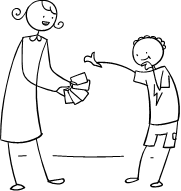 Then have different students come up to you and select a card (hold face down, fanned out, like a card trick). Have them stick the cards onto the board in the right section. For more advanced students you can help them write each sentence, otherwise the teacher can write the sentences next to the cards. Each time, have students copy onto their charts. Continue until all of the cards are on the board with sentences:
Then have different students come up to you and select a card (hold face down, fanned out, like a card trick). Have them stick the cards onto the board in the right section. For more advanced students you can help them write each sentence, otherwise the teacher can write the sentences next to the cards. Each time, have students copy onto their charts. Continue until all of the cards are on the board with sentences:
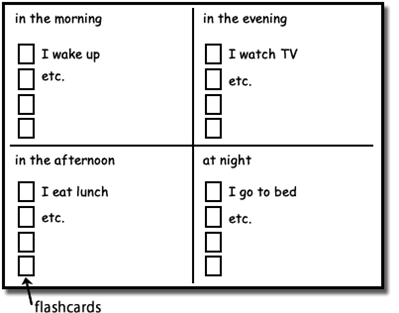
4. Add times to the "Times of the Day" chart"
Your students will have studied telling the time in a previous lesson (see our Telling the Time lesson plan). We are going to add times to the chart.
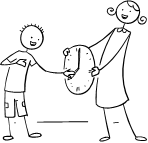 Again, first model: point to "I wake up" on the chart. Do the gesture for waking up (stretching, yawning, rubbing eyes) and then look at your watch. If you have a clock (either real or a craft clock - we have a great clock craft sheet on our crafts page: https://www.eslkidstuff.com/craftsheets.htm) you can hold this up. Set the time to 11:00 and say "I wake up ... at 11 o'clock?". Make sure everyone says "Noooo!". Then ask someone to move the clock hands to a more realistic time, such as 7:00. Write on the board, "at 7 o'clock" after "I wake up". Chorus "I wake up at 7 o'clock in the morning". Get everyone to write the time that they wake up on their charts.
Again, first model: point to "I wake up" on the chart. Do the gesture for waking up (stretching, yawning, rubbing eyes) and then look at your watch. If you have a clock (either real or a craft clock - we have a great clock craft sheet on our crafts page: https://www.eslkidstuff.com/craftsheets.htm) you can hold this up. Set the time to 11:00 and say "I wake up ... at 11 o'clock?". Make sure everyone says "Noooo!". Then ask someone to move the clock hands to a more realistic time, such as 7:00. Write on the board, "at 7 o'clock" after "I wake up". Chorus "I wake up at 7 o'clock in the morning". Get everyone to write the time that they wake up on their charts.
Now have students come up to you, change the time on your clock and write times on the board next to each flashcard (e.g. I eat lunch at 12 o'clock in the afternoon), and make sure these are being chorused and times are being written on the students' charts.
NOTE: For times that are not hourly (e.g. 6.30, 9.55, etc.) you need to decide whether to teach the full times (e.g. half past six, five to ten) or the digital version (six thirty, nine fifty-five).
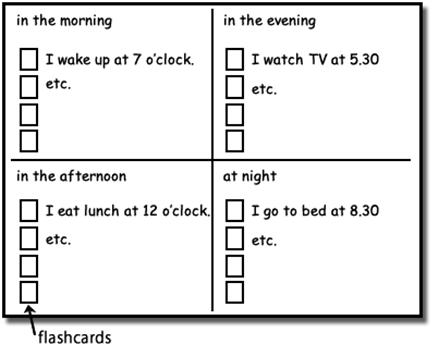
5. Play the "Daily Routines Memory Game"
Erase the chart from the board and take off the flashcards. Put students in pairs and get them to swap charts. Students are going to test each other on the times they do things.
Make sure you model with 2 students first:
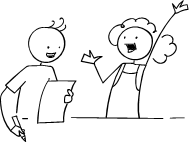 Student A: selects a sentence on Student B's worksheet (e.g. I do homework at 6 o'clock). S/He does the action of doing homework (e.g. writing in an imaginary notebook).
Student A: selects a sentence on Student B's worksheet (e.g. I do homework at 6 o'clock). S/He does the action of doing homework (e.g. writing in an imaginary notebook).
Student B: must guess the action and say the exact sentence on their chart (e.g. "I do homework at 6 o'clock in the evening").
Then it is Student B's turn to select a sentence and do the action. Pairs keep going until they have done all of the sentences on their charts. Make sure students don't allow their partners to get away with mistakes - if they get the time wrong, make them guess again!
6. Do the "What time do you ...? (Survey)" exercise
Give each student the survey worksheet and explain that they are going to ask 6 people in the class (or less, depending on class size) about their daily routines on school days. Before starting, go through the survey sheet with everyone and make sure they write an additional activity on the last row. Then model with a student, showing writing their name at the top of the column and asking and answering questions using the following structure:
Student A: What time do you (wake up)?
Student B: I (wake up) at (7 o'clock) (in the morning).
Have students stand up and mingle, filling in their surveys.
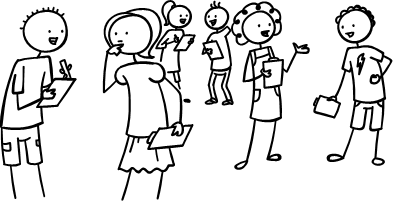
7. Daily Routines Theater
Now let's do a fun activity - your students will make a short theater play! Pair up students but make sure each pair has surveyed the other in the previous activity. They are going to use their survey sheets to make a short play.
For each pair, one student will act out their day whilst the other is the narrator (using the survey to make the narration). Give each pair 5 minutes to practice before coming up to the front of the class and acting out their daily routines, for example:
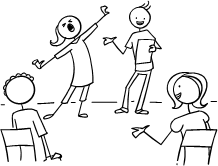 Ken (narrating): Hello, my name is Erika!
Ken (narrating): Hello, my name is Erika!
Erika: (waves to audience)
Ken: I wake up at 7 o'clock in the morning.
Erika: (Pretends to sleep, wake up, stretch and yawn, etc.)
Ken: I eat breakfast at 7:30 in the morning.
Erika: (Pretends to eat cereal, drink juice, etc.)
etc.
Encourage students to make their plays funny and also allow them to add extra parts (e.g. play video games, read a book, ride a bike, etc.).
At the end, get everyone to vote for their favorite play.
8. Read classroom reader "Tom's Cat"
Let's end with a nice story which reinforces the lesson vocab and structures. Before class, download and print off the reader "Tom's Cat". As you go through each page, point to the pictures, elicit each routine action, elicit times on the clocks and times of the day and ask if your students do those things at that time or time of day, for example:
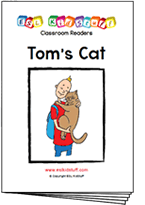 Teacher: What time is it? (pointing at the alarm clock on page 3)
Teacher: What time is it? (pointing at the alarm clock on page 3)
Students: 8 o'clock!
Teacher: Yes, 8 o'clock! At night?
Students: No, in the morning!
Teacher: And what does Tom's cat do at 8 o'clock in the morning?
Students: He sleeps!
Teacher: Yes, how about you Hugo? Do you sleep at 8 o'clock in the morning?
Student (Hugo): No, I don't.
Teacher: Look at Tom. What does he do at 8 o'clock in the morning?
Students: He wakes up!
Teacher: That's right! And what does he do next?
Students: He eats his breakfast and brushes his teeth ...
etc.
 Get the students really involved in the story by asking lots of questions and getting them to tell you about their daily routines.
Get the students really involved in the story by asking lots of questions and getting them to tell you about their daily routines.
After reading the story, give out a reader worksheet to each student and read through the story one more time (without stopping for questions, etc.) as students fill in the missing verbs and write the times. Then go through the answers as a class.
---
Alternatively, watch our video version of the reader (Internet connection required):
1. Assign Homework: "My Day 3" worksheet.
2. Wrap up the lesson with some ideas from our "Warm Up & Wrap Up" page.
 Found a mistake?
Found a mistake?
Please let us know
Full access to all resources on ESL KidStuff including lesson plans, flashcards, worksheets, craft sheets,
song downloads, classroom readers, flashcards app and songs app.